Gas
Disk Model that Might Explain WD1145 Spectroscopic
Observations
Bruce L. Gary, 2016.09.30
Bruce L. Gary, 2016.09.30
Return to 3 of 3 -
2016.01.17 to 2016.07.13
This is my layman's explanation
of a model by Redfield et al (2016) that endeavors
to explain the unusual spectroscopic observations of
WD1145.
Brief
Description of Spectroscopic Observations
Xu et al (2016)
published the following spectrum using the Keck
HIRES spectrograph. It's the average spectral
shape (in terms of Doppler velocity instead of
wavelength) produced by averaging many lines that
were unusually broad ("broad" means spectral width
was much greater than could be produced in the
WD's atmosphere). Most of the 200 absorption lines
that were measured were narrow, and were
identified as originating in the WD atmosphere
("photospheric" lines). The narrow photospheric lines
were used to create a model for prediction of what
should have been observed in the broad line
regions, and ~ 1/3 of the the lines were
dramatically broader, and could not originate from the
atmosphere. The graph below is
an average spectral shape of the broad lines (with
the modeled narrow photospheric lines subtracted, I
think).
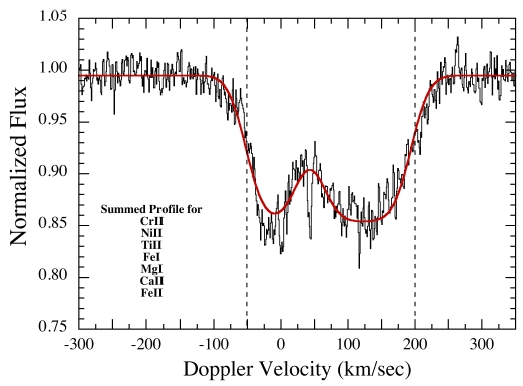
Figure 1. Xu et al (2016) average spectral shape of the "broad" category of absorption lines.
In the Xu et al paper the broad lines were attributed to "circumstellar gas" in high velocity streams surrounding the WD. No explanation was given for the 75 km/s "offset" of what otherwise was a fairly symmetric pattern.
Brief Description of Redfield et al (2016) Model
Redfield et al (2016) published a "gas disk" model. The following diagrams are mine, based on my understanding of their model; I hope my understanding of their model is correct (their description was cryptic for my way of thinking so consider this web page "provisional" until one of the Redfield et al authors checks this).
Consider a narrow tube of gas (atoms, no molecules or grains of dust) that surrounds the WD on it's equatorial plane. Assume further for now that the Earth is viewing WD1145 from within this same equatorial plane. If the torus of gas has a radius of 10 times the WD radius it will look something like this from Earth:

Figure 2. Edge-on view of a narrow gas tube, at inclination = 90 degrees, showing how it crosses the center of the WD disk.
Now imagine a view looking down on the WD, i.e., from a pole direction. The narrow ring of gas is no thicker (in the radial direction) than the width of the uniformly spaced dot symbols. The ring depicted is actually an ellipse, defined by gas that orbits with an eccentricity of 0.05 with the periapsis line on the right (azimuth of closest approach to the WD). The Earth is shown as viewing the WD through the gas ring from a direction of 41 degrees off the periapsis line. Don't worry about these small eccentricity adjustments in the diagram; they're there for use later in this description.
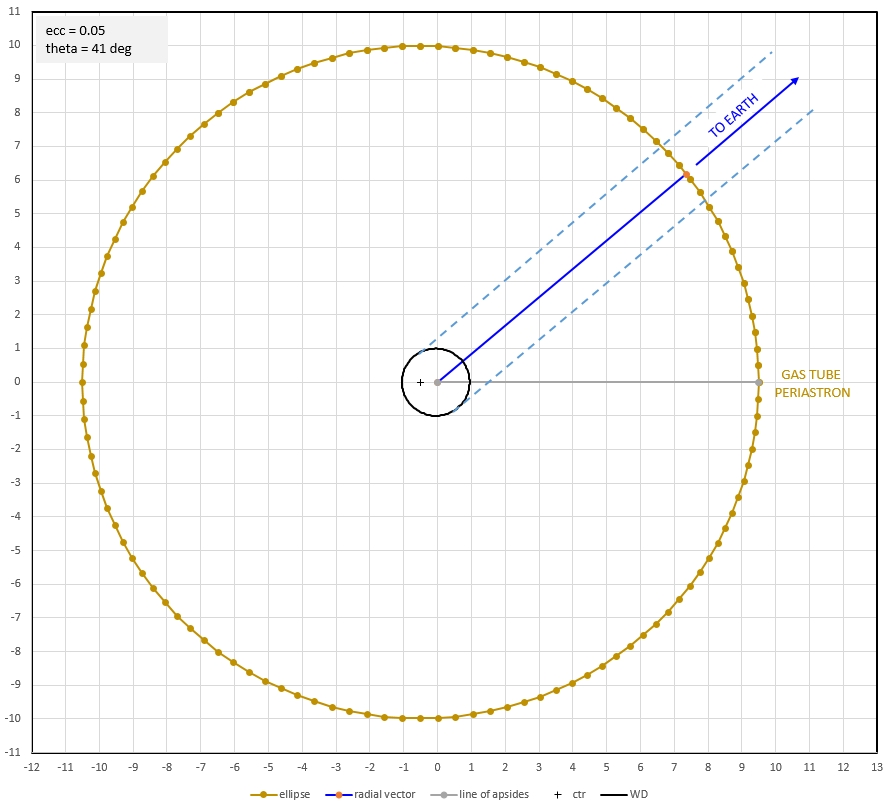
Figure 3. Looking down on the WD (center) with a narrow ring of gas at a distance of 10 WD radii. Earth views the WD from the upper-right, with the gas ring crossing the WD center. Assume that gas is moving clockwise in this ring orbit.
Notice the two dashed blue lines, corresponding to the Earth's line-of-sight (LOS) to the edges of the WD. At this distance from the WD the gas is orbiting at ~ 1000 km/s. The orbital motion is a vector of this magnitude and orientation that rotates 360 during each orbit. Assuming for the moment that eccentricity is zero, the LOS to the WD center will intersect gas moving orthogonal to the LOS; i.e., there is zero component of orbital velocity in the radial direction (along the LOS). Therefore, gas at this part of its path across the WD disk will not exhibit any Doppler shift (again, we're assuming for now that eccentricity is zero). The orbital velocity vector rotates such that it has a continually varying orientation during the passage from the first to last LOS edge lines. This is shown in the next diagram:
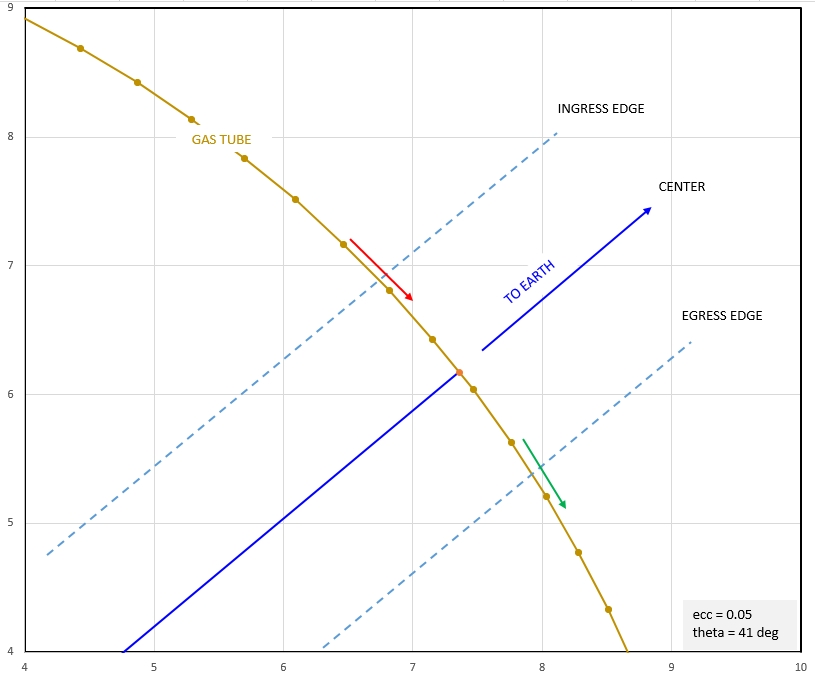
Figure 4. Zoom-in of gas ring's path through the Earth line-of-sight lines. Red arrow represents the orbital velocity vector when gas begins to intercept WD light; green arrow shows the orbital velocity vector when it ends it path across the WD disk.
Notice that orbital velocity vector has an "approaching" component along the ingress edge LOS, and a "receding" component along the egress edge LOS. The difference of each of these LOS components is 100 km/s when the ring has this geometry, with an orbit radius of 10 times the WD radius. During the entire passage in front of the WD disk the LOS component changes by 200 km/s. This is in approximate agreement with the Xu et al spectrum (Fig. 1).
Recall that the Xu et al (2016) spectrum shows the broad feature to be offset ~ 75 km/s in the receding direction. That's where eccentricity is needed. When the orbital velocity vector crosses the center of the WD disk the gas must be receding with that 75 km/s speed. Notice that in this diagram (see Fig. 3) periastron is 41 degrees past the LOS lines, so indeed the gas, as portrayed, is receding from Earth along the center LOS line.
The modeling analysis by Redfield et al (2016) takes these details, and many others, into account in finding a solution that matches their set of spectrum observations. Their model converts the gas ring to a disk (i.e., many gas rings that touch). Here's their solution: inner radius of gas disk = 10 x WD radius, outer radius of gas disk = 64 WD radius, eccentricity = 0.05, i = 89.1 degrees, angle of LOS from periapsis line = 41 degrees.
New View of WD1145
We can now revise the earlier debris disk depiction of what WD1145 would look like if we could see it up close by adding the inner gas disk. I've taken the liberty, temporarily, of modifying the Redfield et al (2106) model by adjusting their inclination from 89.1 degrees to 89.45 degrees, while keeping their gas disk inner and outer radii (10 and 64 WD radii); the greater inclination is preferred for interpreting the dust clouds. (The gas and debris disks don't have to be co-planar, but I'm going to assume they are for my initial future modeling.) Eventually I'll try to combine both observation sets, photometric light curve fades and spectroscopic broad absorption lines shape, to see if there's a model that satisfies both data sets. In the meantime, here's a tentative diagram for how WD1145 might look if we could see the inner gas disk (gray) and the outer debris disk (brown):
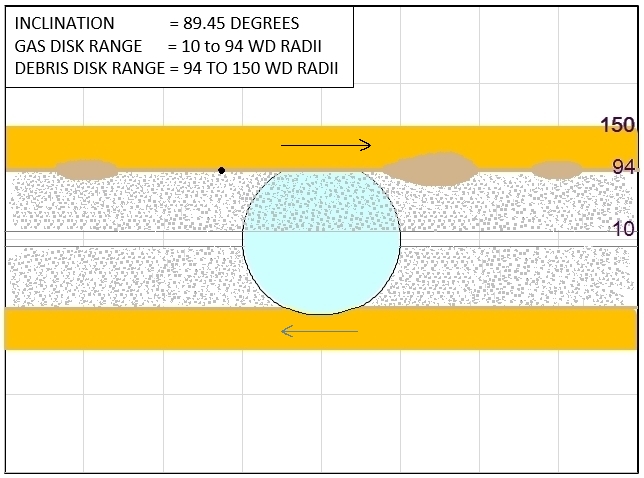
Figure 5. An artistic representation of how WD1145 would look from the Earth's perspective. The black dot represents the A-asteroid, moving to the right and about to produce a transit of 0.08% (too small for detection). The three brown ovals are dust clouds produced by fragments that have broken off the A-asteroid. Our light curves show fades (also called "dips") produced by dust clouds that expand and cover part of the WD disk. The middle dust cloud in this depiction is large enough to have produced a 4% dip (which is detectable using amateur telescopes). The dark tan bands are a debris disk, consisting of dust that has migrated outward from the dust cloud orbits. The debris disk is opaque at the inner regions, and may become transparent due to low dust density in the outer regions. Small dust particles that migrate inward, toward the WD, and become so hot that the constituent atoms sublimate and never recondense, form a disk of metal atoms (such as iron, calcium, aluminum, etc); it is referred to the inner gas disk. The metal atoms absorb light at only specific wavelengths, so most of the WD's light passes through the gas disk, and it is therefore essentially transparent. We believe that both disks have as their source dust from fragments that have broken off the A-asteroid (and 5 others, in slightly larger orbits in the debris disk). The numbers on the right edge show radial distance of edges of the ring system: the inner gas ring begins at 10 x WD radius, the A-asteroid and associated fragments are at 94 x WD radius, the inner edge of the debris disk is also at 94 x WD radius, and the outer edge of debris disk at ~ 150 x WD radius.
Relationship Between Gas Disk and IR Excess Debris Disk
The conventional view is that the gas disk and IR excess debris disk are two components of the same physically coincident disk, as the following quote states (Farihi, 2016, pg. 19): Interestingly, the emitting gas and dust are spatially coincident in all three cases where there are sufficient data to model both components in detail (Melis et al., 2010a). The observed distribution of velocity shifts within the emission lines (Gansicke et al., 2008) places the detected gas in white dwarf disks in essentially the same orbital regions as those inferred for the dust (Brinkworth et al., 2009).
This may be true for the 3 cases studied by Farihi, but let's ask if this is also true for WD1145. Remember, WD1145 is unique in being the only known white dwarf that has an inclination close to 90 degrees in addition to the following: metal polluted atmosphere, circumstellar gas disk, IR excess debris disk.
The WD1145 gas disk is mostly present at distances slightly greater than 10 Rwd (based on the orbital 1000 km/s speed required to account for the 300 km/s gas spectrum width). If the debris disk that produces the IR excess is coincident with the gas disk, then it too would be found as close as 10 Rwd to the WD. Although the gas disk could extend as far as the A-orbit, at 94.4 × Rwd, it's more realistic for it to diminish to essentially nothing at a closer distance, f × Rwd. The ratio of solid angles (i.e., "projected areas") of the gas and debris disks to the WD is therefore (f^2 - 10^2) × cos(i). Let's consider the case of f = 30, just for illustration purposes (i.e., gas & debris disks extend from 10 × Rwd to 30 × Rwd). The ratio of solid angles is then 800 × cos(i). If cos(i) = 1/10 (i.e., i = 84.3 degrees) then the solid angle ratio of ~ 80 is with the solution range of 116 ± 129,61 determined by Vanderburg et al (2015). For this geometry what would be our view from Earth of WD1145 and the debris disk?
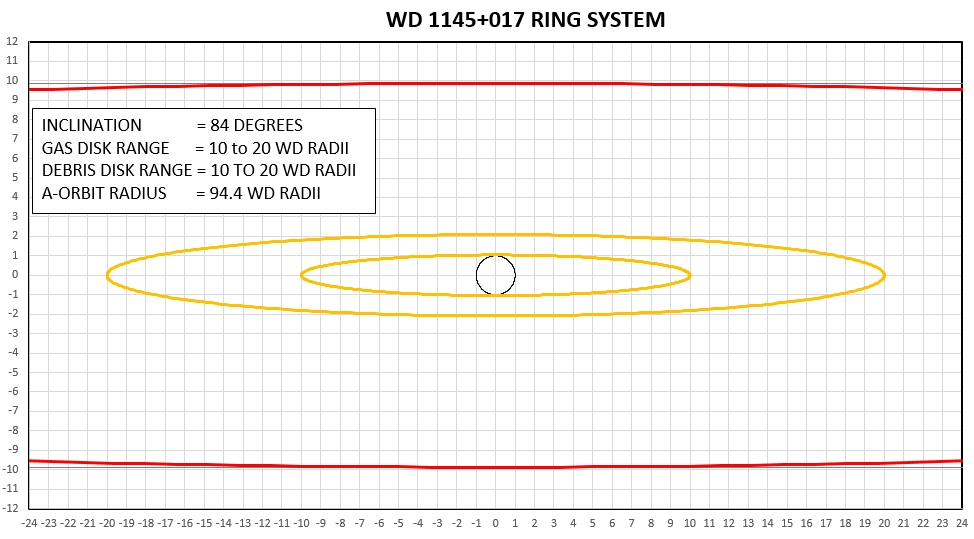
View (from Earth) of the debris disk limits, assuming they extend from 10 to 30 × Rwd (tan ovals) and the A-orbit at 94.4 × Rwd (red oval) if inclination = 84 degrees.
Such a debris disk would just miss occulting the WD. If inclination were any greater we would have to explain why WD1145 does not appear to be partially occulted. But now we have three problems to overcome: 1) how can a debris disk this close to the WD be so cool (recall: Tb ~ 1145 ± 240,195 K, Vanderburg et al, 2015, whereas unshadowed dust grains at ~ 10 × Rwd should have Tphys ~ 4200 K), 2) dust would be so hot inside ~ 50 × Rwd (~1900 K) that dust grains should sublimate to gas long before reaching 10 × Rwd, and 3) how could dust clouds at 94 × Rwd cause dips when its projected distance from the WD edge is 10 × Rwd (when i = 84 deg)?
If dust clouds near the A-orbit do extend > 10 × Rwd in projected distance perpendicular to the orbit plane in order to produce a dip, they are unlikely to have a spatial structure that's confined (in the orbit motion direction) with such a small extent as to produce dips lasting only 4 minutes (which have been observed).
To overcome the last two problems we could increase inclination; but if we did that then the debris disk would start blocking the WD.
I prefer placing the debris disk outside the A-orbit. This solves all previously mentioned problems: 1) brightness temperature of debris disk can be ~ 1145 K (easily modeled), 2) the debris disk won't block the WD, 3) dust clouds will pass the WD near a polar edge and this can easily account for dips of short duration from clouds having small extents perpendicular to their orbit plane.
Conclusion
We need more modeling applied to WD1145.
Also, to have more confidence in all of these speculative models, remember what all scientists say when they feel a little frustrated: WE NEED MORE DATA!
Return to 3 of 3 - 2016.01.17 to 2016.07.13
References
Farihi, J., “Circumstellar Debris and Pollution at White Dwarf Stars,” arXiv:1604.03092v1
Redfield, Seth, Jay Farihi, P. Wilson, Steven G. Parsons, Boris T. Gansicke and Girish Duvvuri, "Spectrosopic Evolution of Disintegrating Planetesimals: Minutes to Months Variability in the Circumstellar Gas Associated with WD 1145+017," arXiv:1608.00549
Xu, S., M. Jura, P. Dufour & B. Zuckerman, 2016, ApJ, 816, L22, arXiv:1511.05973

Figure 1. Xu et al (2016) average spectral shape of the "broad" category of absorption lines.
In the Xu et al paper the broad lines were attributed to "circumstellar gas" in high velocity streams surrounding the WD. No explanation was given for the 75 km/s "offset" of what otherwise was a fairly symmetric pattern.
Brief Description of Redfield et al (2016) Model
Redfield et al (2016) published a "gas disk" model. The following diagrams are mine, based on my understanding of their model; I hope my understanding of their model is correct (their description was cryptic for my way of thinking so consider this web page "provisional" until one of the Redfield et al authors checks this).
Consider a narrow tube of gas (atoms, no molecules or grains of dust) that surrounds the WD on it's equatorial plane. Assume further for now that the Earth is viewing WD1145 from within this same equatorial plane. If the torus of gas has a radius of 10 times the WD radius it will look something like this from Earth:

Figure 2. Edge-on view of a narrow gas tube, at inclination = 90 degrees, showing how it crosses the center of the WD disk.
Now imagine a view looking down on the WD, i.e., from a pole direction. The narrow ring of gas is no thicker (in the radial direction) than the width of the uniformly spaced dot symbols. The ring depicted is actually an ellipse, defined by gas that orbits with an eccentricity of 0.05 with the periapsis line on the right (azimuth of closest approach to the WD). The Earth is shown as viewing the WD through the gas ring from a direction of 41 degrees off the periapsis line. Don't worry about these small eccentricity adjustments in the diagram; they're there for use later in this description.

Figure 3. Looking down on the WD (center) with a narrow ring of gas at a distance of 10 WD radii. Earth views the WD from the upper-right, with the gas ring crossing the WD center. Assume that gas is moving clockwise in this ring orbit.
Notice the two dashed blue lines, corresponding to the Earth's line-of-sight (LOS) to the edges of the WD. At this distance from the WD the gas is orbiting at ~ 1000 km/s. The orbital motion is a vector of this magnitude and orientation that rotates 360 during each orbit. Assuming for the moment that eccentricity is zero, the LOS to the WD center will intersect gas moving orthogonal to the LOS; i.e., there is zero component of orbital velocity in the radial direction (along the LOS). Therefore, gas at this part of its path across the WD disk will not exhibit any Doppler shift (again, we're assuming for now that eccentricity is zero). The orbital velocity vector rotates such that it has a continually varying orientation during the passage from the first to last LOS edge lines. This is shown in the next diagram:

Figure 4. Zoom-in of gas ring's path through the Earth line-of-sight lines. Red arrow represents the orbital velocity vector when gas begins to intercept WD light; green arrow shows the orbital velocity vector when it ends it path across the WD disk.
Notice that orbital velocity vector has an "approaching" component along the ingress edge LOS, and a "receding" component along the egress edge LOS. The difference of each of these LOS components is 100 km/s when the ring has this geometry, with an orbit radius of 10 times the WD radius. During the entire passage in front of the WD disk the LOS component changes by 200 km/s. This is in approximate agreement with the Xu et al spectrum (Fig. 1).
Recall that the Xu et al (2016) spectrum shows the broad feature to be offset ~ 75 km/s in the receding direction. That's where eccentricity is needed. When the orbital velocity vector crosses the center of the WD disk the gas must be receding with that 75 km/s speed. Notice that in this diagram (see Fig. 3) periastron is 41 degrees past the LOS lines, so indeed the gas, as portrayed, is receding from Earth along the center LOS line.
The modeling analysis by Redfield et al (2016) takes these details, and many others, into account in finding a solution that matches their set of spectrum observations. Their model converts the gas ring to a disk (i.e., many gas rings that touch). Here's their solution: inner radius of gas disk = 10 x WD radius, outer radius of gas disk = 64 WD radius, eccentricity = 0.05, i = 89.1 degrees, angle of LOS from periapsis line = 41 degrees.
New View of WD1145
We can now revise the earlier debris disk depiction of what WD1145 would look like if we could see it up close by adding the inner gas disk. I've taken the liberty, temporarily, of modifying the Redfield et al (2106) model by adjusting their inclination from 89.1 degrees to 89.45 degrees, while keeping their gas disk inner and outer radii (10 and 64 WD radii); the greater inclination is preferred for interpreting the dust clouds. (The gas and debris disks don't have to be co-planar, but I'm going to assume they are for my initial future modeling.) Eventually I'll try to combine both observation sets, photometric light curve fades and spectroscopic broad absorption lines shape, to see if there's a model that satisfies both data sets. In the meantime, here's a tentative diagram for how WD1145 might look if we could see the inner gas disk (gray) and the outer debris disk (brown):

Figure 5. An artistic representation of how WD1145 would look from the Earth's perspective. The black dot represents the A-asteroid, moving to the right and about to produce a transit of 0.08% (too small for detection). The three brown ovals are dust clouds produced by fragments that have broken off the A-asteroid. Our light curves show fades (also called "dips") produced by dust clouds that expand and cover part of the WD disk. The middle dust cloud in this depiction is large enough to have produced a 4% dip (which is detectable using amateur telescopes). The dark tan bands are a debris disk, consisting of dust that has migrated outward from the dust cloud orbits. The debris disk is opaque at the inner regions, and may become transparent due to low dust density in the outer regions. Small dust particles that migrate inward, toward the WD, and become so hot that the constituent atoms sublimate and never recondense, form a disk of metal atoms (such as iron, calcium, aluminum, etc); it is referred to the inner gas disk. The metal atoms absorb light at only specific wavelengths, so most of the WD's light passes through the gas disk, and it is therefore essentially transparent. We believe that both disks have as their source dust from fragments that have broken off the A-asteroid (and 5 others, in slightly larger orbits in the debris disk). The numbers on the right edge show radial distance of edges of the ring system: the inner gas ring begins at 10 x WD radius, the A-asteroid and associated fragments are at 94 x WD radius, the inner edge of the debris disk is also at 94 x WD radius, and the outer edge of debris disk at ~ 150 x WD radius.
Relationship Between Gas Disk and IR Excess Debris Disk
The conventional view is that the gas disk and IR excess debris disk are two components of the same physically coincident disk, as the following quote states (Farihi, 2016, pg. 19): Interestingly, the emitting gas and dust are spatially coincident in all three cases where there are sufficient data to model both components in detail (Melis et al., 2010a). The observed distribution of velocity shifts within the emission lines (Gansicke et al., 2008) places the detected gas in white dwarf disks in essentially the same orbital regions as those inferred for the dust (Brinkworth et al., 2009).
This may be true for the 3 cases studied by Farihi, but let's ask if this is also true for WD1145. Remember, WD1145 is unique in being the only known white dwarf that has an inclination close to 90 degrees in addition to the following: metal polluted atmosphere, circumstellar gas disk, IR excess debris disk.
The WD1145 gas disk is mostly present at distances slightly greater than 10 Rwd (based on the orbital 1000 km/s speed required to account for the 300 km/s gas spectrum width). If the debris disk that produces the IR excess is coincident with the gas disk, then it too would be found as close as 10 Rwd to the WD. Although the gas disk could extend as far as the A-orbit, at 94.4 × Rwd, it's more realistic for it to diminish to essentially nothing at a closer distance, f × Rwd. The ratio of solid angles (i.e., "projected areas") of the gas and debris disks to the WD is therefore (f^2 - 10^2) × cos(i). Let's consider the case of f = 30, just for illustration purposes (i.e., gas & debris disks extend from 10 × Rwd to 30 × Rwd). The ratio of solid angles is then 800 × cos(i). If cos(i) = 1/10 (i.e., i = 84.3 degrees) then the solid angle ratio of ~ 80 is with the solution range of 116 ± 129,61 determined by Vanderburg et al (2015). For this geometry what would be our view from Earth of WD1145 and the debris disk?

View (from Earth) of the debris disk limits, assuming they extend from 10 to 30 × Rwd (tan ovals) and the A-orbit at 94.4 × Rwd (red oval) if inclination = 84 degrees.
Such a debris disk would just miss occulting the WD. If inclination were any greater we would have to explain why WD1145 does not appear to be partially occulted. But now we have three problems to overcome: 1) how can a debris disk this close to the WD be so cool (recall: Tb ~ 1145 ± 240,195 K, Vanderburg et al, 2015, whereas unshadowed dust grains at ~ 10 × Rwd should have Tphys ~ 4200 K), 2) dust would be so hot inside ~ 50 × Rwd (~1900 K) that dust grains should sublimate to gas long before reaching 10 × Rwd, and 3) how could dust clouds at 94 × Rwd cause dips when its projected distance from the WD edge is 10 × Rwd (when i = 84 deg)?
If dust clouds near the A-orbit do extend > 10 × Rwd in projected distance perpendicular to the orbit plane in order to produce a dip, they are unlikely to have a spatial structure that's confined (in the orbit motion direction) with such a small extent as to produce dips lasting only 4 minutes (which have been observed).
To overcome the last two problems we could increase inclination; but if we did that then the debris disk would start blocking the WD.
I prefer placing the debris disk outside the A-orbit. This solves all previously mentioned problems: 1) brightness temperature of debris disk can be ~ 1145 K (easily modeled), 2) the debris disk won't block the WD, 3) dust clouds will pass the WD near a polar edge and this can easily account for dips of short duration from clouds having small extents perpendicular to their orbit plane.
Conclusion
We need more modeling applied to WD1145.
Also, to have more confidence in all of these speculative models, remember what all scientists say when they feel a little frustrated: WE NEED MORE DATA!
Return to 3 of 3 - 2016.01.17 to 2016.07.13
References
Farihi, J., “Circumstellar Debris and Pollution at White Dwarf Stars,” arXiv:1604.03092v1
Redfield, Seth, Jay Farihi, P. Wilson, Steven G. Parsons, Boris T. Gansicke and Girish Duvvuri, "Spectrosopic Evolution of Disintegrating Planetesimals: Minutes to Months Variability in the Circumstellar Gas Associated with WD 1145+017," arXiv:1608.00549
Xu, S., M. Jura, P. Dufour & B. Zuckerman, 2016, ApJ, 816, L22, arXiv:1511.05973